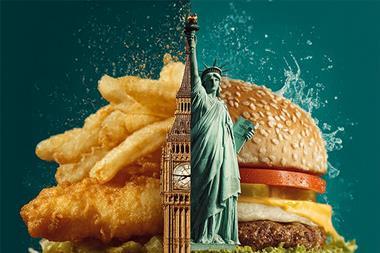Street food market operator, Kerb, has highlighted its top 10 trends to watch for 2018. They include no-frills restaurants; stem-to-root dining and the return of some retro favourites. The predictions also include the bold claim that 2018 could see the “death of food chains”.
1. Retro foods make a comeback
In 2018 we’re expecting to see more nostalgic classics, like pop-tarts, s’mores, soft serve ice cream and slushies. Back in July we jumped on this band wagon and threw a two-day party under the canopy at King’s Cross, jam packed with some of London’s most memorable noshes and guiltiest pleasures, including arctic rolls, prawn cocktails, chip butties, sausage sarnies…and more. We expect to see much more along these lines from our traders and for customers to continue to crave new takes on childhood classics they know and love.
2. Vegan food get’s an unhealthy make over
We’ve no doubt that veganism will continue to grow in the coming year, with more meat and dairy substitutes (like alternative milks, jackfruit and an increasing number of soya-based products) being adopted and vegan tourism becoming the norm. But, how will 2018 differ from the year before? We think vegans will seek out indulgent and decadent meat-free dishes that rival their non-vegan counterparts. There are only so many buddha bowls one person can eat, so we think it’s time for some jackfruit chicken wings from Biff’s Jack Shack, a tofu fish burrito from Club Mexicana and melting chocolate brownie mud pie from Young Vegans.
3. Finding our own sense of balance
Despite the odd bout of indulgence (vegan or otherwise) many of our city’s residents will continue to seek out a more balanced way of eating to combat the increasingly busy, crowded and fast-paced nature of the city. Especially in light of certain economic and political uncertainty, we are all tending to feel increasingly stressed, tired and anxious about the future. In an effort to compensate for this we are seeking out healthier and more balanced eating and exercise habits that fit with our unique lifestyle, tastes and routines. So generally, there is a greater emphasis on health and balance, but the definition for “healthy” living and eating is becoming increasingly blurred. For some people it means less meat and dairy, for others it’s no-cards or fewer calories, for an increasing number it means cutting down on processed foods. In any case, the ability for food businesses to offer flexibility and their ability to adapt to more tailored tastes and dietary requirements, will be increasingly important to their success in the future.
4. London looks for new regional cuisines
Us Londoners have always been at the fore of international and fusion food. In fact, in the city, it is probably easier to find a good and authentic ramen, dumpling or curry then it is to find a proper pie or fish and chips. In 2018 we’re expecting to see more diversification or Asian and African cuisine with a lot more regional specialities and choice, such as Taiwanese, Shanghainese and Tibetan food from China, Gujarati, Tamil and Bengali food from India and more Eritrean, Kenyean and north African dishes.
5. We’ll be making it our own with more personalised foods
“Immersive dining”, “personalisation”, “customisation”…“co-creation”? Whatever it’s called, we think that there will be a more hands-on approach to dining in the coming year, with more deli-style restaurants and self-serve venues popping up. Why? Perhaps one small consequence of a slight over-saturation of concept restaurants and fine dining in London, is the possibility that we miss a good old fashioned rapport with restaurant staff and we want to feel more connected to the food being made and the people making it. This is why street food has been so popular, and will continue to be.
6. A more conscious consumer calls for action
We’ve heard a lot of rumbling about sustainability in the last year, on topics such as food waste, animal welfare, the environmental impact of food production and recycling, which has spurred on a greater consumer interest in buying locally sourced, free range and organic products. In 2018 these rumbles will turn into roars and we expect a lot of businesses to get serious on issues of sustainability in response to this growing consumer consciousness.
As part of this we are expecting to see more british seasonal foods and dishes popping up on our streets. At KERB we work closely with our traders to help advise them on best practices regarding energy use, food waste, recycling and ethical sourcing. In 2018 we’ll be setting targets for our traders in terms of sourcing and being responsible in the waste they produce. We’re going to work hard in the coming year to help ensure that 100% of our waste from markets doesn’t go to landfill and will be setting internal restrictions on recycling and use of food waste.
7. Stem-to-root dining experiences
As an offshoot (pardon the pun) of a more conscious consumer and a greater emphasis on food waste, we are expecting to see more chefs challenging themselves to create menus using every part of the plant and for Londoners to seek out these dishes, not just in support of sustainability, but as a result of burgeoning curiosity and a thirst for new and inventive ingredients, dishes and dining experiences.
8. Specialists are the new food heroes
We’re set to see more specialist restaurants, street food, producers and shops on our streets in 2018. Restaurants like Padella and Bao, who focus on producing one thing expertly well, are setting the trend for new food businesses in the coming year. This is part of the reason why we think street food has grown so successfully, and will continue to grow. Our traders work hard to perfect just one or two dishes that they hold close to their hearts and the result is better quality at better prices, which people are crying out for more of.
9. The death of food chains
Ok “death” may be a bit dramatic, but we are expecting to see the typical food chain restaurant model struggle in the near future. Factors like increasing business rates, food costs and staff shortages are all making it harder for food franchises and chain restaurants to operate and compete. The upside of this, however, is greater opportunities for smaller businesses and a more innovative use of retail space.
10. Keeping it simple with no frills dining
No frills means no nonsense and we expect to see a return of focus on good quality food and good prices in 2018, without the fuss and fanfare. Good examples of this trend are seen in the growing popularity of minimalist scandinavian style restaurants, more traditional neighbourhood joints and a return of the food court. The running themes being a focus on the core offering, authenticity, a pared-down approach to service and a simple yet functional (often under stylised) interior, all of which hope to improve the quality of the food and make it more affordable for diners.










































